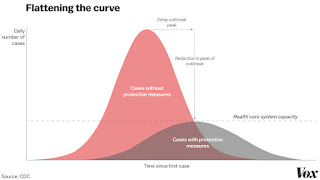Comparison to the number of flu deaths (say 30,000 a year) and the current number of COVID-19 deaths misses several major points when viewed from a national or international level. Humans have been exposed to various flu viruses for many generations. Many have partial or full immunity to certain strains; large percentages of older folks in the U.S. get annual flu shots[i]. None of us has any immunity to COVID-19.
Flu spreads widely, but because of vaccines and partial immunity, slowly. Last year, the CDC estimated 35.5 million of us got sick with influenza, 16.5 went to a health care provider; 490,000 were hospitalized, and 34,000 died.[ii]
COVID-19 spreads rapidly through exposed populations. That explosive growth can (and did in China) overwhelm hospital facilities in any country. Some years of severe flu have also overwhelmed hospitals, but to a lesser extent than projections of what an unconstrained COVID-19 epidemic will cause.
Even if COVID-19 acted the same as flu it could cause an additional half million hospitalizations. At that level, the system is in trouble. But COVID-19 spreads faster than the flu (because of the lack of immunity) and is more deadly.
The death rates in a typical flu year are less than 1% for those over age 65. The COVID-19 death rate for the 50-59 group are estimated at 1.3%, for 60-69 at 3.6%, for 70-79 at 8% and for 80+ at 14.8%.[iii]
Now, project much higher rates of infection because of the virgin population, combined with much higher rates of mortality, and the resulting projection of deaths from an unconstrained COVID-19 is significantly higher than that from flu. Unless we moderate the speed of infection, our healthcare system will collapse under the weight of these additional illnesses. China may be able to build a hospital in a week, but in the U.S., we wouldn't even have the permit after a week's time.
Do extreme measures controlling population movements limit the number of cases? Maybe, but that is not the only objective of decreasing the opportunities for the virus to spread. One key from a public health perspective is to not overwhelm the health care system. An unconstrained virus infects a population very quickly and then is done because new hosts are no longer available. A constrained virus will take much longer to run its course, may or may not have the same overall exposure, but smooths out the number of infections over time--meaning the health care system has a much better chance of treating the ill.
Here's a graphical representation of this “flattening of the curve” taken from Vox:
The flu has a naturally flattened curve because of immunity and vaccinations compared to COVID-19. As we have already seen in pockets of exposure, unchecked by social distancing precautions, COVID-19 spreads very rapidly.
Treating COVID-19 with the same disregard as we do the flu (Oh, it only kills 30,000 people a year.) will lead to a major healthcare crisis in the U.S. Aggressively acting to slow it down is important to all of us, even the younger generations who have little to personally fear from catching the disease.
Closing on a more hopeful note, Apple announced it has reopened all its stores in China.[iv] As the bad news continues to pile up, we should remember that this too shall pass.
[i] The CDC
estimated nearly 175 million doses of flu vaccine were distributed for the
2019-2020 flu season
* * * * *
James M. Jackson authors the Seamus McCree series. Full of mystery and suspense, these thrillers explore financial crimes, family relationships, and what happens when they mix. False Bottom, the sixth and most recent novel in the series is set in the Boston area. You can sign up for his newsletter and find more information about Jim and his books at https://jamesmjackson.com.

No comments:
Post a Comment